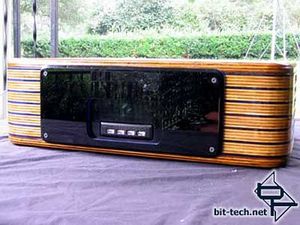Using these materials in a "planar" manner has its challenges and advantages. It limits certain types of construction but also enables some really unique posibililties. It's not the most efficient (or lightweight) option as far as material usage but it's solid and will last forever (which turns out to be about 5 years when you have kids). I chose a very simplistic design with a few ambitious features since this was my first time trying to fabricate anything using this technique but your options are limited only to your imagination.
I understand why Kerry Vesper bonds his layers first and then sands and stains last. Doing it in that order allows you to, more or less, sculpt an impressive product from a rough beginning. He hasn't alternated acrylic in his work (to my knowledge); that's what cause me to deviate and come up with my own build technique.
Here are a few things I learned if anyone is interested in trying this technique:
Lastly, not only did bit-tech step up and provide everything I could not provide myself, several manufacturers embraced this project and sent some of the top kit for this type of system that could be found. I'd like to give them recognition and thanks for filling this box with what we consider top elements for a HTPC:
Bit-Tech: ponied up the Asus Motherboard, Kingmax Dual Channel RAM, and AMD Barton 3000 XP.

ATi provided a 9800 All-in-Wonder. Our review can be found here.
 Logitech
Logitech
provided a set of Z-680 THX certified 5.1 Speakers. Our review can be found here.

M-Audio provided a Revolution 7.1 sound card.

Matrix Orbital provided a VK202-24-USB VFD display.

Maxtor provided a 200GB 8Mb Cache ATA133 DiamondMax Plus 9 hard drive.

Plextor provided a PX-504A DVD+RW drive.

Provided the Pyramid Fan Controller and Quiet Feet.

Raidmax provided the PS-400W Aluminum blue power supply.

I understand why Kerry Vesper bonds his layers first and then sands and stains last. Doing it in that order allows you to, more or less, sculpt an impressive product from a rough beginning. He hasn't alternated acrylic in his work (to my knowledge); that's what cause me to deviate and come up with my own build technique.
Here are a few things I learned if anyone is interested in trying this technique:
- Plan, plan, plan - nothing substitutes for a firm plan, in my case, the elements going in the case dictated a lot of the design. For me, I had a crystal clear image of what I wanted the outside appearance to be but the internals dictated a lot of the nuts-n-bolts of the design.
- Be flexible and adaptive - This may seem to contradict my first point but it doesn't. Things don't always work right and a project that takes as long as this one did to complete, new ideas and problems arise. Use those opportunities to improve the quality and design of your project. Otherwise, you will go mad.
- Get jiggy with it - If I had to do it all again, I would've created a jig for all my pieces and cut them all out with the router for more exact matching pieces. The more uniform the pieces, the less sanding you will need to do.
- Good materials and the right tools. Use good wood with interesting character and you can't go wrong (I realize we're talking about plywood but there are lots of options). Using the correct tools for the job can dramatically improve your results and save you time and materials. I used pretty much every item in my shop for this one. I realize that not everyone has a ton of tools but keep your available arsenal in the back of your mind when planning your fabrications.
- Use people - bit-tech provides an amazing range of talents and brains... tap those brains. I had several people aware of this project and their contributions can't be overlooked. They provided knowledge, experience, and fresh perspecive. This project could not have been completed without their input and support.
Lastly, not only did bit-tech step up and provide everything I could not provide myself, several manufacturers embraced this project and sent some of the top kit for this type of system that could be found. I'd like to give them recognition and thanks for filling this box with what we consider top elements for a HTPC:
Bit-Tech: ponied up the Asus Motherboard, Kingmax Dual Channel RAM, and AMD Barton 3000 XP.

ATi provided a 9800 All-in-Wonder. Our review can be found here.
 Logitech
Logitechprovided a set of Z-680 THX certified 5.1 Speakers. Our review can be found here.

M-Audio provided a Revolution 7.1 sound card.

Matrix Orbital provided a VK202-24-USB VFD display.

Maxtor provided a 200GB 8Mb Cache ATA133 DiamondMax Plus 9 hard drive.

Plextor provided a PX-504A DVD+RW drive.

Provided the Pyramid Fan Controller and Quiet Feet.

Raidmax provided the PS-400W Aluminum blue power supply.


MSI MPG Velox 100R Chassis Review
October 14 2021 | 15:04








Want to comment? Please log in.